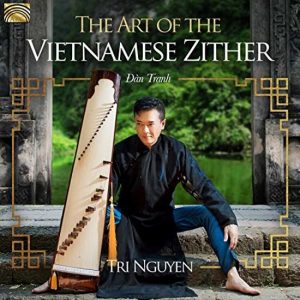 De Vietnamese zither is een niet zo’n bekend instrument in West-Europa. En dat is erg jammer, aangezien de dan-tranh (zoals de Vietnamezen het instrument noemen) een prachtig twinkelende klank heeft die bijzonder goed past bij het strijkkwartet dat Tri Nguyen op innovatieve wijze toevoegt aan zijn muziek.
De Vietnamese zither is een niet zo’n bekend instrument in West-Europa. En dat is erg jammer, aangezien de dan-tranh (zoals de Vietnamezen het instrument noemen) een prachtig twinkelende klank heeft die bijzonder goed past bij het strijkkwartet dat Tri Nguyen op innovatieve wijze toevoegt aan zijn muziek.
English version below
De legende vertelt dat het 16-snarige tokkelinstrument de dan-tranh is onstaan uit een ruzie tussen twee zusjes die beiden tegelijkertijd op de 32-snarige zither wilde oefenen. Ze wilden allebei studeren op de dan-tranh, maar samen op één instrument repeteren, tegelijkertijd, dat geeft ruzie. Hun vader werd zo boos dat hij de zither in twee stukken zaagde, en ieder kind een deel gaf. Zo konden ze allebei afzonderlijk studeren op het 16-snarige instrument, ‘de dan-tranh’, dat zijn naam ontleent aan deze ruzie: dan betekent instrument en tranh betekent ruzie.
- Voor luisteren klik hier
De Vietnamese muziek is relatief onbekend in West-Europa. Het één-snarige instrument de dan-bau heeft nog enige bekendheid door de in Parijs wonende gitarist Nguyen Le, die samen met dan-bau virtuoos Ngô Hông Quang een voortreffelijk cross-over album maakte van Vietnamese en westerse muziek. Op de CD The Art of the Vietnamese Zither van dan-tranh-speler Tri Nguyen staat de dan-tranh centraal, maar is de dan-bau ook te horen op de slot-track Black Riding Horse. Tri Ngyuen is een virtuoos op dit instrument. Hij blijft iets meer bij de Vietnamese signatuur, maar toch gaat ook hij op zoek naar de muzikale randen. Hij voegt op geweldige wijze o.a. een strijkkwartet toe aan zijn muziek. Veel (verstild) unisono-spel waarbij de vier strijkers dezelfde ritmiek spelen, met een fenomenaal resultaat dat een beetje doet denken aan het album ‘Pieces Of Africa‘ van het Kronos Quartet uit 1992. Het gevolg is een tintelende cross-over van Vietnamese muziek die, zoals veel Aziatische muziek, gestoeld is op pentatoniek. De vijf toonstoonladder die binnen de (Vietnamese) muziek rijkelijk wordt versierd met trillers die Tri Ngyuen op natuurlijke wijze laat horen. Daarnaast voegt hij de oud (Arabische luit) en Orientaalse percussie aan zijn composities toe (o.a. in Child where are you……), dat weer een geheel nieuw en verfrissend metier laat horen. Tri Ngyuen schreef en arrangeerde alle stukken waarmee hij een wereldlijke vlucht van Azië naar de Oriënt en de westerse wereld maakt. Dat Tri Ngyuen een wereldburger is, konden we al eerder horen op zijn CD ‘Beyond Borders’ (in een mix van Corsicaanse polyfonie en doedelzakmuziek) en ook met dit album The Art of the Vietnamese Zither horen we hem in grensverleggende muziek waarmee hij excelleert in een prachtig mondiale voorsprong.
English version
The Vietnamese zither is not a well-known instrument in Western Europe. And that is a shame, since the dan-tranh (as the Vietnamese call it) has a beautiful twinkling sound that fits particularly well with the string quartet that Tri Nguyen adds to his music in an innovative way.
- For listening click here
Legend goes that the 16-string plucking instrument the dan-tranh arose from an argument between two sisters who both wanted to practice on the 32-string zither at the same time. They got into a fight, because practicing together on one instrument is not possible. Their father became so angry that he cut the zither into two pieces, and gave each child a part. On this way they could both practice on the 16-string instrument, ’the dan-tranh’, which takes its name from this argument: dan means instrument and tranh means argument.
Vietnamese music is relatively unknown in Western Europe. The one-string instrument the dan-bau still became well-known because of guitarist Nguyen Le, who lives in Paris and recorded a record with the dan-bau virtuoso Ngô Hông Quang, An excellent crossover album of Vietnamese and Western music. On the CD The Art of the Vietnamese Zither by dan-tranh player Tri Nguyen the dan-tranh is the central instrument but the dan-bau can also be heard on the final track Black Riding Horse. Tri Ngyuen is a virtuoso on the dan-tranh who keeps the Vietnamese signature, but he also goes in search for musical cross-overs. In a great way he adds a string quartet to his music. A lot of (silently) unison play in which the string quartet play the same rhythm, with a phenomenal result that is somewhat reminiscent of the ‘Pieces Of Africa’ album by the Kronos Quartet (1992). The result is a tingling crossover of Vietnamese music that, like many Asian music, is based on pentatonics. The five-tone scale that is richly decorated in (Vietnamese) music with ornaments that Tri Ngyuen plays naturally. In addition, he adds the oud (Arabic lute) and Oriental percussion to his compositions (like in Child where are you ……), which shows a completely new and refreshing way of his music. Tri Ngyuen wrote and arranged all the pieces with which he made a cosmic flight from Asia to the Orient and the western world. We already knew that Tri Ngyuen is a world citizen on his CD Beyond Borders (in a mix of Corsican polyphony and bagpipe music) and also with this new album The Art of the Vietnamese Zither he produced groundbreaking music with a lovely and beautiful global mind.
- Tri Nguyen: ‘The Art of the Vietnamese Zither’ (ARC Music / Music & Words)
- Picture: Virginie Le Gall
© Mattie Poels.

Geen reacties